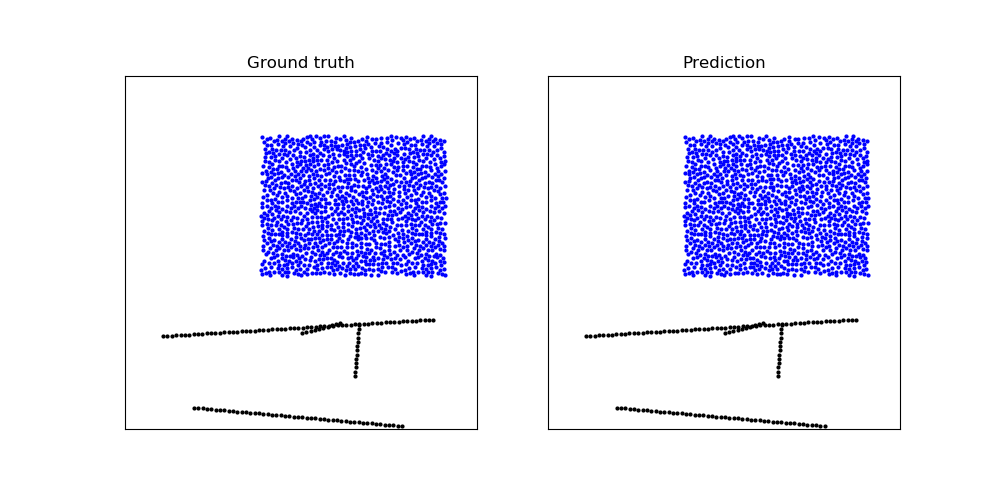ICML poster: icml.cc/virtual/2020/poster/6849
Video site: sites.google.com/view/learning-to-simulate
ArXiv: arxiv.org/abs/2002.09405
If you use the code here please cite this paper:
@inproceedings{sanchezgonzalez2020learning,
title={Learning to Simulate Complex Physics with Graph Networks},
author={Alvaro Sanchez-Gonzalez and
Jonathan Godwin and
Tobias Pfaff and
Rex Ying and
Jure Leskovec and
Peter W. Battaglia},
booktitle={International Conference on Machine Learning},
year={2020}
}
module load cuda/10.0
module load cudnn/7.6.2
After downloading the repo, and from the parent directory. Install dependencies:
pip install -r learning_to_simulate/requirements.txt
mkdir -p /tmp/rollous
Download dataset (e.g. WaterRamps):
mkdir -p /tmp/datasets
bash ./learning_to_simulate/download_dataset.sh WaterRamps /tmp/datasets
Train a model:
mkdir -p /tmp/models
python -m learning_to_simulate.train \
--data_path=/tmp/datasets/WaterRamps \
--model_path=/tmp/models/WaterRamps
Generate some trajectory rollouts on the test set:
mkdir -p /tmp/rollouts
python -m learning_to_simulate.train \
--mode="eval_rollout" \
--data_path=/tmp/datasets/WaterRamps \
--model_path=/tmp/models/WaterRamps \
--output_path=/tmp/rollouts/WaterRamps
Plot a trajectory:
python -m learning_to_simulate.render_rollout \
--rollout_path=/tmp/rollouts/WaterRamps/rollout_test_0.pkl
Datasets are available to download via:
-
Metadata file with dataset information (sequence length, dimensionality, box bounds, default connectivity radius, statistics for normalization, ...):
https://storage.googleapis.com/learning-to-simulate-complex-physics/Datasets/{DATASET_NAME}/metadata.json -
TFRecords containing data for all trajectories (particle types, positions, global context, ...):
https://storage.googleapis.com/learning-to-simulate-complex-physics/Datasets/{DATASET_NAME}/{DATASET_SPLIT}.tfrecord
Where:
-
{DATASET_SPLIT}is one of:trainvalidtest
-
{DATASET_NAME}one of the datasets following the naming used in the paper:WaterDropWaterSandGoopMultiMaterialRandomFloorWaterRampsSandRampsFluidShakeFluidShakeBoxContinuousWaterDrop-XLWater-3DSand-3DGoop-3D
The provided script ./download_dataset.sh may be used to download all files from each dataset into a folder given its name.
An additional smaller dataset WaterDropSample, which includes only the first two trajectories of WaterDrop for each split, is provided for debugging purposes.
train.py: Script for training, evaluating and generating rollout trajectories.learned_simulator.py: Implementation of the learnable one-step model that returns the next position of the particles given inputs. It includes data preprocessing, Euler integration, and a helper method for building normalized training outputs and targets.graph_network.py: Implementation of the graph network used at the core of the learnable part of the model.render_rollout.py: Visualization code for displaying rollouts such as the example animation.{noise/connectivity/reading}_utils.py: Util modules for adding noise to the inputs, computing graph connectivity and reading datasets form TFRecords.model_demo.py: example connecting the model to input dummy data.
Note this is a reference implementation not designed to scale up to TPUs (unlike the one used for the paper). We have tested that the model can be trained with a batch size of 2 on a single NVIDIA V100 to reach similar qualitative performance (except for the XL and 3D datasets due to OOM).
